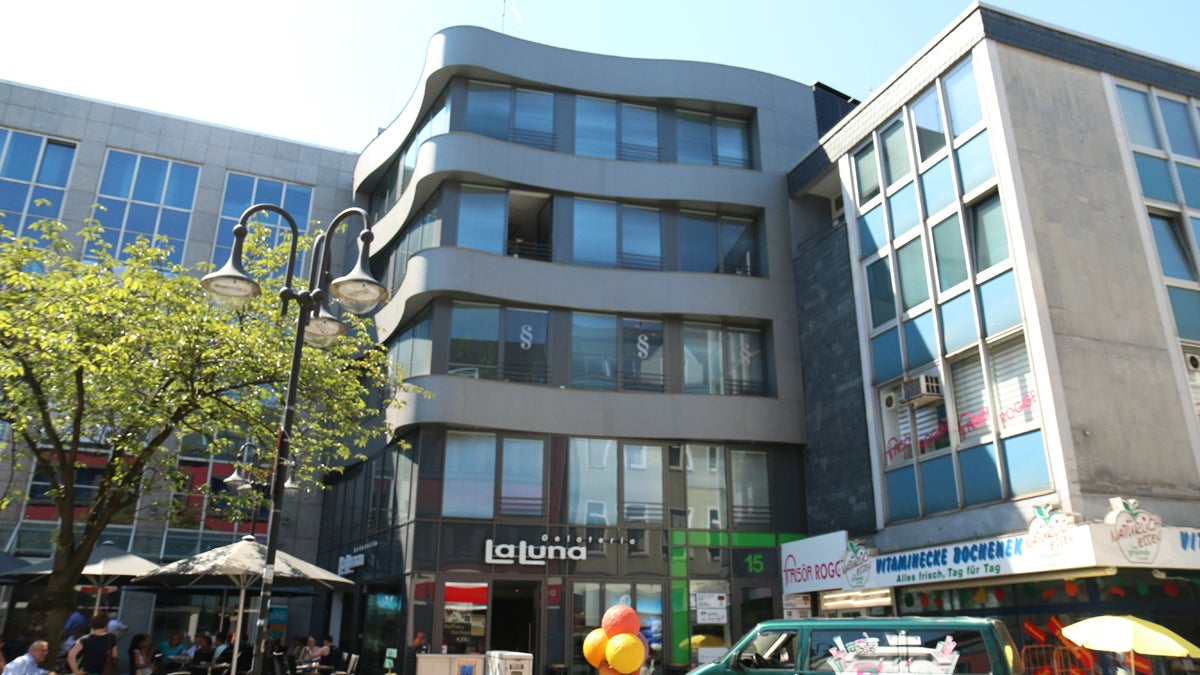German coal city tries to make a green comeback

A retrofitted office/apartment building in Bottrop, Germany. (Marielle Segarra/WHYY)
The seventh in a series of Keystone Crossroads posts from German cities.
The German city of Bottrop is known for its coal mine, Prosper-Haniel, which employs 5,300 people and will shut down by 2018.
Bottrop’s unemployment rate was eight percent at the end of May 2015, compared to a national average of 4.7 percent. Many of the city’s 116,500 residents live in poverty, according to the city.
But urban planners have decided to change the city’s image, and they hope, the lives of its citizens, through green initiatives.
In 2010, Bottrop won a national competition held by a local business association to help a city in the region remake itself as a model for sustainable urban development. The project is partly government-funded, with the state providing at least €25 million (about $28 million) and private investors supplying many million more. Bottrop is halfway through the project.
I visited Bottrop this summer, fresh from a year of reporting on Pennsylvania cities, many of which are former industrial centers striving to rebrand themselves as a hub for one thing or another.
A few years ago, Chester, where the Sun Shipbuilding and Drydock Company employed 35,000 people before shutting down in the 1980s, hoped a new casino and soccer stadium would turn it into an entertainment destination. That hasn’t happened. Scranton, once a center of the now-shuttered coal and iron industries, hopes to become a hub for “eds and meds.”
Bottrop’s project made us wonder: is it possible to revitalize a struggling city by going green? And has that ever worked in the U.S. Rust Belt?
The plan
Bottrop’s plan centers around one neighborhood — home to 59 percent of the population — that now doubles as a sort of laboratory.
The aim is to cut CO2 emissions in half from this neighborhood over 10 years and to improve residents’ quality of life by introducing more public transit options, parks and green infrastructure. Efforts include hundreds of projects within the neighborhood, such as retrofitting public buildings and installing charging stations for electric vehicles, among other changes.
These projects alone won’t get Bottrop to its goal.
Thirty-seven percent of CO2 emissions in Germany come from existing buildings, and most of those buildings are privately owned, said Klaus Müller, head of the municipal office for the project. So in order to reach its goal, the city needs people to retrofit their homes and businesses.
Retrofitting can include renovating heating systems, replacing windows and doors, insulating a roof and other measures. The average cost to retrofit a detached house in the city is between €20,000–40,000 (about $22,400–45,000), Müller said.
As you might expect in a distressed city, many people in Bottrop don’t have the money to make such an investment, even though the improvements could save them money in the long term. And as is the case throughout Germany, Bottrop’s elderly population is growing.
The city’s elderly residents wonder why they should invest in energy efficiency, said Christa Reicher, a professor for urban design at Technical University Dortmund who is analyzing the project. “The elder people, they say…’I will live here several years and then somebody else will own my building. So why should I invest in a building which is usable for me not for so long’?” Reicher said.
To engage the community, Innovation City Management, a public-private partnership that manages the project, reaches out to residents directly, offering them free consultations about how much energy and money they could save by retrofitting their homes. The city also reimburses building owners for up to 25 percent of their cost.
Despite the challenges, Müller says the city has enjoyed some success. He cites the city’s retrofitting rate — the percentage of people who retrofitted their homes — as evidence.
In Bottrop, 3.9 percent of private residential building owners retrofitted their homes each year between mid-2011 and mid-2013, Müller said. In Germany, an annual average of 1.4 percent of people retrofitted their homes between 2001 and 2010, according to the Leibniz Institute of Ecological Urban and Regional Development, a German research group.
The two figures are not directly comparable. But they’re the only numbers available, and Müller says they suggest that the city’s attempts to engage residents are working. It’s difficult to know for sure, because the city didn’t track its retrofitting rate before the project started.
Regardless, there’s a big issue Bottrop isn’t tackling in its attempts to go green: the loss of jobs from the shuttering of the Prosper-Haniel coal mine.
The majority of the miners will retire by 2018 and some others will be retrained to go on to a different job. The rest will face unemployment without a lot of job prospects.
Still, that’s 5,300 jobs the city no longer has to offer its residents.
The hope is that the investment in green projects will eventually yield jobs and that the hoped-for shift in Bottrop’s reputation will inspire firms to relocate or open in the city.
But who can count on that? And if it doesn’t happen, well…who really cares what people think of your city, if many of your residents are unemployed and live in poverty?
Examples from the Rust Belt
It’s worth considering how similar attempts are working out in the Rust Belt.
Vandergrift, Pennsylvania, a borough of about 5,000 people, set out to make its own green comeback 10 years ago.
With the help of a grant from the National Science Foundation, researchers and students at the University of Pittsburgh planned to harness the power of the city’s river to create electricity. The borough also expanded its farmers’ market and planted trees, according to the Associated Press.
It’s unclear how successful those initiatives have been. The borough’s website says nothing about going green. We reached out to the borough, its mayor, its council president and its improvement program, but none returned requests for comment.
Braddock, Pennsylvania, an even smaller borough with only 2,100 residents, used to be a center for the steel industry. Lately, it has made headlines for its attempts at green revitalization. Among other things, Mayor John Fetterman created Braddock Redux, a nonprofit focusing on the arts, youth and green initiatives.
A 2008 story by the PBS Newshour, called “Green Industry Hub Rises From Rust Belt Ruins,” detailed how Fetterman wanted to turn brownfields into sites for eco-friendly businesses and attract more residents by making the borough a hub for the new, green economy.
At the time, Braddock was having some success luring sustainable businesses, including an urban farm called Braddock Farms and Fossil Free Fuel, a firm that retrofits diesel cars and trucks to run on vegetable oil.
Seven years later, Tina Doose, a council member in the borough, says the town has made some “inroads” when it comes to sustainability. She cites the farm and the renovation of a number of existing buildings. Those buildings have not been retrofitted specifically for the purpose of energy efficiency, but the changes made — like new windows — may yield some energy savings.
If we’re talking about a comeback, though, the borough’s progress has been underwhelming.
But Doose says green initiatives alone won’t solve the borough’s problems, anyway. “For a town like Braddock, it’s going to take more than that,” she said. Sustainability “definitely could be a cornerstone and a key part to revitalization,” she added. “But can it be the only thing? I don’t think so.”
Another Rust Belt city, Greensburg, Kansas, was destroyed by a tornado in 2007. With the help of insurance and taxpayer money, it also tried to rebuild itself as a green city, according to an NPR story from 2014.
Seven years later, the town had about 800 residents — half its pre-tornado population. People disagree how much of that loss is because of the tornado and how much can be attributed to the green strategy’s unsuccessful attempt to spur growth.
Darin Headrick, Greesnburg’s superintendent, told NPR the city needed more time to develop. “When the tornado happened, we were around 100 years old,” he said. “We’re seven years old right now, just about. What do we need? We need time. You grow communities a family at a time. You grow them a job at a time.”
Larger cities like Philadelphia and Pittsburgh have had success with sustainability, but they aren’t using those initiatives, exclusively, to turn the city around.
Cleveland, another large Rust Belt city, is attempting to change its image and turn its economy towards a green future. The city has a robust climate action plan and is tracking specific goals.
But Cleveland has a lot of other things going for it, too: major industry, health and arts institutions. Unlike some of the other places “reinventing,” it’s not a city completely devoid of resources, with a withering population. Comeback stories are hard to find among those kinds of cities.
Looking forward
Ideally, a city could do it all: reduce carbon emissions, provide green jobs for locals and improve the quality of life for residents.
But smaller, financially distressed municipalities — the ones that arguably need a comeback the most — typically don’t have the financial means or the personnel to do what a green revitalization might require. That’s not to say cities shouldn’t invest time and money in sustainability. But expecting those initiatives to turn the city around might be unrealistic.
It remains to be seen whether Bottrop will shift its fortunes through sustainability or just lower its carbon emissions. Less pollution is an admirable goal, but it’s not, in itself, a comeback strategy. Bottrop will release a progress report on the project later this year.
This summer, I spent several weeks in Germany as part of a German/American journalist exchange program through the RIAS Berlin Kommission and the Radio Television Digital News Foundation. I’m sharing lessons on urban planning and revitalization from German cities, including stories and photos on an urban garden in Berlin, bike-friendly infrastructure in Münster, adaptive reuse of former coal mines in Essen and an artists’ quarter created by the city of Hamburg.
Do you know of any Pennsylvania municipalities where green initiatives are reigniting a community? Email me at msegarra@whyy.org or tweet at me @mariellesegarra.
WHYY is your source for fact-based, in-depth journalism and information. As a nonprofit organization, we rely on financial support from readers like you. Please give today.


